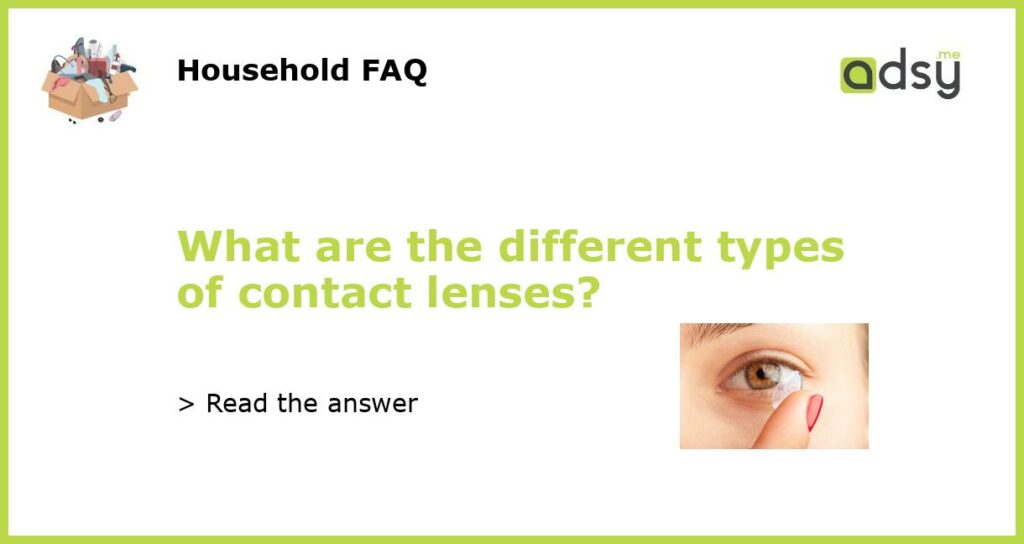The Different Types of Contact Lenses
When it comes to vision correction, contact lenses have become a popular choice for many people. They offer convenience, comfort, and the freedom to see clearly without the need for glasses. With advances in technology, there are now several types of contact lenses available to suit different vision needs and lifestyles. In this article, we will explore the different types of contact lenses and their benefits.
Soft Contact Lenses
Soft contact lenses are the most common type of contact lenses used today. They are made from a flexible plastic material called hydrogel or silicone hydrogel, which allows oxygen to reach the cornea, making them comfortable to wear for long periods. Soft contact lenses come in various forms, including daily disposables, weekly or bi-weekly disposables, monthly disposables, and extended wear lenses.
Daily disposable lenses are designed to be worn for a single day and then discarded. They are great for people who have allergies or those who want the convenience of not having to clean and store their lenses. Weekly or bi-weekly disposables are replaced on a weekly or bi-weekly basis, depending on the brand. Monthly disposables are replaced once a month, while extended wear lenses can be worn continuously for up to 30 days and nights without needing to be removed.
Rigid Gas Permeable (RGP) Contact Lenses
Rigid gas permeable (RGP) contact lenses are made from a harder, oxygen-permeable material compared to soft lenses. They provide crisp and clear vision and are especially beneficial for people with astigmatism or higher prescriptions. RGP lenses allow more oxygen to reach the cornea, reducing the risk of eye irritation and infection.
Although RGP lenses may require a longer adaptation period compared to soft lenses, many people find them more comfortable once they become accustomed to wearing them. RGP lenses also have a longer lifespan and are more resistant to deposits, making them a cost-effective option in the long run.
Toric Contact Lenses
Toric contact lenses are specifically designed to correct astigmatism, a common vision condition that occurs when the cornea is shaped more like a football rather than a round basketball. Astigmatism can cause blurred or distorted vision, and toric lenses compensate for the irregular shape of the cornea.
Toric lenses are available in both soft and RGP materials. Soft toric lenses are more popular due to their comfort and ease of use. They have different powers in different meridians, allowing them to correct astigmatism effectively. RGP toric lenses, on the other hand, offer sharper vision and more stable lens positioning, making them suitable for people with more complex astigmatism.
Multifocal Contact Lenses
As we age, our ability to switch focus between near and far objects becomes more challenging, leading to the need for reading glasses or bifocals. Multifocal contact lenses are designed to address this issue by providing clear vision at various distances, eliminating the need for separate glasses.
Multifocal lenses come in both soft and RGP materials. Soft multifocals have a gradual transition between lens powers, allowing for seamless vision at different distances. RGP multifocals have distinct zones for near, intermediate, and distance vision, providing crisp and clear vision at all distances.
Colored Contact Lenses
Colored contact lenses are a popular choice for people who want to change or enhance their eye color. They are available as both prescription and non-prescription lenses. Colored lenses can be found in different shades and patterns, allowing individuals to achieve various looks.
Colored contact lenses are typically made from a soft hydrogel material, providing comfort and ease of use. They can be used for cosmetic purposes or to correct vision, depending on the individual’s needs. It’s important to note that colored contact lenses should always be obtained with a prescription and under the guidance of an eye care professional to ensure proper fit and safety.
In conclusion, there are several types of contact lenses available to suit different vision correction needs and preferences. Whether you opt for soft contact lenses, RGP lenses, toric lenses, multifocal lenses, or colored lenses, it’s crucial to consult with an eye care professional to determine the best option for your eyes and lifestyle.






